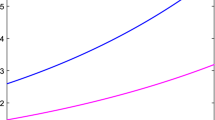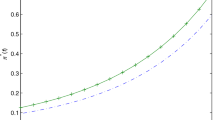Appendix: The Proof of Theorem 1
Proof
We prove this theorem by mathematical induction. For \(t=T-1\), by equations (4), (12) and (13), we have
$$\begin{aligned}&V_{T\!{-}\!1}\left( x_{T-1},r_{T{-}1},y_{T-1}\right) {=}\max _{\pi _{T{-}1}}\left\{ \mathbb {E}_{x_{T{-}1},r_{T-1},y_{T{-}1}}\left( V_{T}\left( X_{T},R_{T},Y_{T}\right) \right) -\omega \mathbb {E}_{x_{T-1},r_{T-1},y_{T-1}}\left( g^{2}_{T}\left( X_{T},R_{T},Y_{T}\right) \right) \right. \nonumber \\&\qquad \qquad \qquad \qquad \qquad \qquad \left. +\omega \left[ \mathbb {E}_{x_{T-1},r_{T-1},y_{T-1}}\left( g_{T}\left( X_{T},R_{T},Y_{T}\right) \right) \right] ^{2}\right\} \nonumber \\&\quad =\max _{\pi _{T-1}}\left\{ \mathbb {E}_{x_{T-1},r_{T-1},y_{T-1}}\left( X_{T}\right) -\omega \mathbb {E}_{x_{T-1},r_{T-1},y_{T-1}}\left( X_{T}^{2}\right) + \omega \left[ \mathbb {E}_{x_{T-1},r_{T-1},y_{T-1}}\left( X_{T}\right) \right] ^{2}\right\} \nonumber \\&\quad =\max _{\pi _{T-1}}\left\{ x_{T-1}r_{T-1}+\mathbb {E}(P'_{T-1})\pi _{T-1}+c_{T-1}y_{T-1}-\omega \pi _{T-1}'Var (P_{T-1})\pi _{T-1}\right\} . \end{aligned}$$
(A1)
Because \(\omega >0\) and \(Var (P_{T-1})\) is positive definite by Assumption 2, the first-order (necessary and sufficient) condition about \(\pi _{T-1}\) in (A1) gives the optimal strategy
$$\begin{aligned} \pi ^{*}_{T-1}=\frac{1}{2\omega }Var ^{-1}(P_{T-1})\mathbb {E}(P_{T-1}). \end{aligned}$$
(A2)
Substituting equation (A2) into equations (A1) and (13), respectively, we can obtain
$$\begin{aligned} V_{T-1}\left( x_{T-1},r_{T-1},y_{T-1}\right)= & {} r_{T-1}x_{T-1}+c_{T-1}y_{T-1}+\frac{1}{4\omega }\mathbb {E} (P'_{T-1})Var ^{-1}(P_{T-1})\mathbb {E}(P_{T-1}), \end{aligned}$$
(A3)
$$\begin{aligned} g_{T-1}(x_{T-1},r_{T-1},y_{T-1})= & {} \mathbb {E}_{x_{T-1},r_{T-1},y_{T-1}}\left( g_{T}\left( X_{T},R_{T},Y_{T}\right) \right) \nonumber \\= & {} \mathbb {E}\left( x_{T-1}r_{T-1}+P'_{T-1}\pi _{T-1}+c_{T-1}y_{T-1}\right) \nonumber \\= & {} r_{T-1}x_{T-1}+c_{T-1}y_{T-1}+\frac{1}{2\omega }\mathbb {E}(P'_{T-1})Var ^{-1}(P_{T-1})\mathbb {E}(P_{T-1}).\nonumber \\ \end{aligned}$$
(A4)
On the other hand, by equations (14)-(25), we have
$$\begin{aligned}&\psi _{T-1}=1,\text { }w_{T-1}=A_{T}\mathbb {E}\left( b_{T-1}^{2\psi _{T}}\right) +B_{T}^{2}Var \left( b_{T-1}^{\psi _{T}}\right) =0,\\&\xi _{T-1}=A_{T}\mathbb {E}\left( b_{T-1}^{2\psi _{T}}\right) \mathbb {E}\left( P_{T-1}P'_{T-1}\right) +B_{T}^{2}Var \left( b_{T-1}^{\psi _{T}}P_{T-1}\right) =Var \left( P_{T-1}\right) ,\\&A_{T-1}=w_{T-1}-w_{T-1}^{2}\mathbb {E}(P'_{T-1})\xi ^{-1}_{T-1}\mathbb {E}(P_{T-1})=0,\\&B_{T-1}=B_{T}\left[ \mathbb {E}\left( b_{T-1}^{\psi _{T}}\right) -w_{T-1}\mathbb {E}\left( b_{T-1}^{\psi _{T}}\right) \mathbb {E}(P'_{T-1})\xi ^{-1}_{T-1}\mathbb {E}(P_{T-1})\right] =1,\\&f_{T-1}=B_{T}^{2}\mathbb {E}^{2}\left( b_{T-1}^{\psi _{T}}\right) \mathbb {E}(P'_{T-1})\xi ^{-1}_{T-1}\mathbb {E}(P_{T-1})+f_{T}=\mathbb {E}(P'_{T-1})Var ^{-1}(P_{T-1})\mathbb {E}(P_{T-1}).\\&Q^{T-1}_{T-1}=w_{T-1}\mathbb {E}(P_{T-1})=0,\ \ U^{T-1}_{T-1}=A_{T-1}=0,\ \ \beta ^{T-1}_{T-1}=B_{T-1}=1,\ \ \alpha ^{T-1}_{T-1}=A_{T-1}=0.\nonumber \\ \end{aligned}$$
Hence, we obtain
$$\begin{aligned} \pi ^{*}_{T-1}=\xi _{T-1}^{-1}\left( \frac{B_{T}\mathbb {E}\left( b_{T-1}^{\psi _{T}}\right) \mathbb {E}(P_{T-1})}{2\omega r_{T-1}^{\varphi _{T-1}\psi _{T}}}-w_{T-1}r_{T-1}x_{T-1}\mathbb {E}(P_{T-1})-Q^{T-1}_{T-1}c_{T-1}y_{T-1}\right) , \end{aligned}$$
(A5)
$$\begin{aligned} V_{T-1}(x_{T-1},r_{T-1},y_{T-1})&=-\omega A_{T-1}r_{T-1}^{2\psi _{T-1}}x_{T-1}^{2}+B_{T-1}r_{T-1}^{\psi _{T-1}}x_{T-1}+\frac{1}{4\omega }f_{T-1}+\beta ^{T-1}_{T-1}r_{T-1}^{\varphi _{T-1}\psi _{T}}c_{T-1}y_{T-1}\nonumber \\&\qquad -2\omega U^{T-1}_{T-1}r_{T-1}^{\psi _{T-1} +\varphi _{T-1}\psi _{T}}c_{T-1}y_{T-1}x_{T-1} -\omega \alpha ^{T-1}_{T-1}r_{T-1}^{2\varphi _{T-1}\psi _{T}}c^{2}_{T-1}y^{2}_{T-1}\nonumber \\&\qquad -2\omega \sum _{T-1\leqslant l< h\leqslant T-1}S^{l,h}_{t} r_{t}^{\left( \prod _{m=t}^{l}\varphi _{m}\right) \psi _{l+1} +\left( \prod _{m=t}^{h}\varphi _{m}\right) \psi _{h+1}}c_{l}c_{h}y^{2}_{t} \end{aligned}$$
(A6)
and
$$\begin{aligned} g_{T-1}(x_{T-1},r_{T-1},y_{T-1})&=B_{T-1}r_{T-1}^{\psi _{T-1}}x_{T-1}+\frac{1}{2\omega }f_{T-1}\nonumber \\&\quad +\beta ^{T-1}_{T-1}r_{T-1}^{\varphi _{T-1}\psi _{T}}c_{T-1}y_{T-1}. \end{aligned}$$
(A7)
Equations (A5)-(A7) show that equations (26)-(28) hold for \(t=T-1\).
Now, suppose that equations (26)-(28) hold for \(t=T-1,T-2,\cdots ,t+1\). Then, we consider the case for \(t=t\). Substituting equations (27) and (28), the expressions of \(V_{t+1}\) and \(g_{t+1}\), into the extended Bellman equation (12), we have
$$\begin{aligned}&V_{t}(x_{t},r_{t},y_{t})=\max _{\pi _{t}}\left\{ \mathbb {E}_{x_{t},r_{t},y_{t}}\left( V_{t+1}\left( X_{t+1},R_{t+1},Y_{t+1}\right) \right) -\omega \mathbb {E}_{x_{t},r_{t},y_{t}}\left( g_{t+1}^{2}\left( X_{t+1},R_{t+1},Y_{t+1}\right) \right) \right. \nonumber \\&\left. \qquad \qquad \qquad \qquad +\omega \left[ \mathbb {E}_{x_{t},r_{t},y_{t}}\left( g_{t+1}\left( X_{t+1},R_{t+1},Y_{t+1}\right) \right) \right] ^{2}\right\} \nonumber \\&\quad =\max _{\pi _{t}}\left\{ \mathbb {E}_{x_{t},r_{t},y_{t}}\left( -\omega A_{t+1}R_{t+1}^{2\psi _{t+1}}X_{t+1}^{2}+B_{t+1}R_{t+1}^{\psi _{t+1}}X_{t+1} +\sum _{l=t+1}^{T-1}\beta ^{l}_{t+1}R_{t+1}^{\left( \prod _{m=t+1}^{l}\varphi _{m}\right) \psi _{l+1}}c_{l}Y_{t+1}\right. \right. \nonumber \\&\left. \left. \qquad -2\omega \sum _{l=t+1}^{T-1}U^{l}_{t+1} R_{t+1}^{\psi _{t+1}+\left( \prod _{m=t+1}^{l}\varphi _{m}\right) \psi _{l+1}}c_{l}Y_{t+1}X_{t+1}-\omega \sum _{l=t+1}^{T-1} \alpha ^{l}_{t+1} R_{t+1}^{2\left( \prod _{m=t+1}^{l}\varphi _{m}\right) \psi _{l+1}}c^{2}_{l}Y^{2}_{t+1} \right. \right. \nonumber \\&\qquad \left. \left. +\frac{1}{4\omega }f_{t+1}-2\omega \sum _{t+1\leqslant l< h\leqslant T-1}S^{l,h}_{t+1} R_{t+1}^{\left( \prod _{m=t+1}^{l}\varphi _{m}\right) \psi _{l+1} +\left( \prod _{m=t+1}^{h}\varphi _{m}\right) \psi _{h+1}}c_{l}c_{h}Y^{2}_{t+1}\right) \right. \nonumber \\&\qquad \left. -\omega \mathbb {E}_{x_{t},r_{t},y_{t}}\left( \left( B_{t+1}R_{t+1}^{\psi _{t+1}}X_{t+1}+\frac{1}{2\omega }f_{t+1} +\sum _{l=t+1}^{T-1}\beta ^{l}_{t+1}R_{t+1}^{\left( \prod _{m=t+1}^{l}\varphi _{m}\right) \psi _{l+1}}c_{l}Y_{t+1}\right) ^{2}\right) \right. \nonumber \\&\qquad \left. +\omega \left[ \mathbb {E}_{x_{t},r_{t},y_{t}}\left( B_{t+1}R_{t+1}^{\psi _{t+1}}X_{t+1}+\frac{1}{2\omega }f_{t+1} +\sum _{l=t+1}^{T-1}\beta ^{l}_{t+1}R_{t+1}^{\left( \prod _{m=t+1}^{l}\varphi _{m}\right) \psi _{l+1}}c_{l}Y_{t+1}\right) \right] ^{2}\right\} \nonumber \\&\quad =-\omega w_{t}r_{t}^{2\psi _{t}}x_{t}^{2} +B_{t+1}\mathbb {E}\left( b_{t}^{\psi _{t+1}}\right) r_{t}^{\psi _{t}}x_{t} +\frac{1}{4\omega }f_{t+1}+B_{t+1}\mathbb {E}\left( b_{t}^{\psi _{t+1}}\right) r_{t}^{\varphi _{t}\psi _{t+1}}c_{t}y_{t}\nonumber \\&\qquad -\omega w_{t}r_{t}^{2\varphi _{t}\psi _{t+1}}c_{t}^{2}y_{t}^{2}-2\omega w_{t}r_{t}^{1+2\varphi _{t}\psi _{t+1}}c_{t}y_{t}x_{t}\nonumber \\&\qquad -2\omega \sum _{l=t+1}^{T-1}\left( U^{l}_{t+1}\mathbb {E}\left( b_{t}^{\psi _{t+1}+\left( \prod _{m=t+1}^{l}\varphi _{m}\right) \psi _{l+1}}\theta _{t}\right) +\beta ^{l}_{t+1}B_{t+1} cov \left( b_{t}^{\psi _{t+1}},b_{t}^{\left( \prod _{m=t+1}^{l}\varphi _{m}\right) \psi _{l+1}}\theta _{t}\right) \right) \nonumber \\&\qquad \times r_{t}^{\psi _{t}+\left( \prod _{m=t}^{l}\varphi _{m}\right) \psi _{l+1}}c_{l}y_{t}x_{t} +\sum _{l=t+1}^{T-1}\beta ^{l}_{t+1}\mathbb {E}\left( b_{t}^{\left( \prod _{m=t+1}^{l}\varphi _{m}\right) \psi _{l+1}}\theta _{t}\right) r_{t}^{\left( \prod _{m=t}^{l}\varphi _{m}\right) \psi _{l+1}}c_{l}y_{t}\nonumber \\&\qquad -2\omega \sum _{l=t+1}^{T-1}\left( U^{l}_{t+1}\mathbb {E}\left( b_{t}^{\psi _{t+1}+\left( \prod _{m=t+1}^{l}\varphi _{m}\right) \psi _{l+1}}\theta _{t}\right) +\beta ^{l}_{t+1}B_{t+1} cov \left( b_{t}^{\psi _{t+1}},b_{t}^{\left( \prod _{m=t+1}^{l}\varphi _{m}\right) \psi _{l+1}}\theta _{t}\right) \right) \nonumber \\&\qquad \times r_{t}^{\varphi _{t}\psi _{t+1}+\left( \prod _{m=t}^{l}\varphi _{m}\right) \psi _{l+1}}c_{l}c_{t}y^{2}_{t}\nonumber \\&\qquad -\omega \sum _{l=t+1}^{T-1}M_{t}^{l} r_{t}^{2\left( \prod _{m=t}^{l}\varphi _{m}\right) \psi _{l+1}}c^{2}_{l}y_{t}^{2} -2\omega \sum _{t+1\leqslant l< h\leqslant T-1}N_{t}^{l,h} r_{t}^{\left( \prod _{m=t}^{l}\varphi _{m}\right) \psi _{l+1} +\left( \prod _{m=t}^{h}\varphi _{m}\right) \psi _{h+1}}c_{l}c_{h}y^{2}_{t}\nonumber \\&\qquad +\max _{\pi _{t}}\left\{ -2\omega r_{t}^{1+2\varphi _{t}\psi _{t+1}}w_{t}\mathbb {E}\left( P'_{t}\right) \pi _{t}x_{t}-2\omega r_{t}^{2\varphi _{t}\psi _{t+1}}w_{t}\mathbb {E}\left( P'_{t}\right) \pi _{t}c_{t}y_{t} -\omega r_{t}^{2\varphi _{t}\psi _{t+1}}\pi '_{t}\xi _{t}\pi _{t}\right. \nonumber \\&\qquad \left. +B_{t+1}r_{t}^{\varphi _{t}\psi _{t+1}}\mathbb {E}\left( b_{t}^{\psi _{t+1}}\right) \mathbb {E}\left( P'_{t}\right) \pi _{t}-2\omega \sum _{l=t+1}^{T-1} r_{t}^{\varphi _{t}\psi _{t+1}+\left( \prod _{m=t}^{l}\varphi _{m}\right) \psi _{l+1}}c_{l}y_{t}\left( Q_{t}^{l}\right) '\pi _{t}\right\} . \end{aligned}$$
(A8)
Because \(\omega >0\), \(r_{t}=R_{t}>0\) and \(\xi _{t}\) is positive definite by Remark 3.2, then the first-order condition about \(\pi _{t}\) in (A8) gives the optimal strategy
$$\begin{aligned} \pi ^{*}_{t}=\xi _{t}^{-1}\left( \frac{B_{t+1}\mathbb {E}\left( b_{t}^{\psi _{t+1}}\right) \mathbb {E}(P_{t})}{2\omega r_{t}^{\varphi _{t}\psi _{t+1}}}-w_{t}r_{t}x_{t}\mathbb {E}(P_{t})-\sum _{l=t}^{T-1}Q_{t}^{l}r_{t}^{\left( \prod _{m=t}^{l}\varphi _{m}\right) \psi _{l+1} -\varphi _{t}\psi _{t+1}}c_{l}y_{t}\right) . \end{aligned}$$
(A9)
Substituting equation (A9) into equations (A8) and (13), we can obtain
$$\begin{aligned}&V_{t}(x_{t},r_{t},y_{t}) =-\omega \left( w_{t}-w_{t}^{2}\mathbb {E}(P'_{t})\xi ^{-1}_{t}\mathbb {E}(P_{t})\right) r_{t}^{2\psi _{t}}x_{t}^{2}\nonumber \\&\qquad +B_{t+1}\left( \mathbb {E}\left( b_{t}^{\psi _{t+1}}\right) -w_{t}\mathbb {E}\left( b_{t}^{\psi _{t+1}}\right) \mathbb {E}(P'_{t})\xi ^{-1}_{t}\mathbb {E}(P_{t})\right) r_{t}^{\psi _{t}}x_{t}\nonumber \\&\qquad +\frac{1}{4\omega }\left( B_{t+1}^{2}\mathbb {E}^{2}\left( b_{t}^{\psi _{t+1}}\right) \mathbb {E}(P'_{t})\xi ^{-1}_{t}\mathbb {E}(P_{t})+f_{t+1}\right) -2\omega A_{t}r_{t}^{\psi _{t}+\varphi _{t}\psi _{t+1}}c_{t}y_{t}x_{t}\nonumber \\&\qquad -2\omega \sum _{l=t+1}^{T-1}\left( U^{l}_{t+1}\mathbb {E}\left( b_{t}^{\psi _{t+1}+\left( \prod _{m=t+1}^{l}\varphi _{m}\right) \psi _{l+1}}\theta _{t}\right) \right. \nonumber \\&\qquad \left. +\beta ^{l}_{t+1}B_{t+1} cov \left( b_{t}^{\psi _{t+1}},b_{t}^{\left( \prod _{m=t+1}^{l}\varphi _{m}\right) \psi _{l+1}}\theta _{t}\right) \right. \nonumber \\&\qquad \left. -w_{t}\left( Q^{l}_{t}\right) '\xi ^{-1}_{t}\mathbb {E}(P_{t})\right) r_{t}^{\psi _{t}+\left( \prod _{m=t}^{l}\varphi _{m}\right) \psi _{l+1}}c_{l}y_{t}x_{t}\nonumber \\&\qquad +B_{t+1}\left( \mathbb {E}\left( b_{t}^{\psi _{t+1}}\right) -w_{t}\mathbb {E}\left( b_{t}^{\psi _{t+1}}\right) \mathbb {E}(P'_{t})\xi ^{-1}_{t}\mathbb {E}(P_{t})\right) r_{t}^{\varphi _{t}\psi _{t+1}}c_{t}y_{t}\nonumber \\&\qquad +\sum _{l=t+1}^{T-1}\left( \beta ^{l}_{t+1}\mathbb {E}\left( b_{t}^{\left( \prod _{m=t+1}^{l}\varphi _{m}\right) \psi _{l+1}}\theta _{t}\right) -\mathbb {E}\left( b_{t}^{\psi _{t+1}}\right) B_{t+1}\left( Q^{l}_{t}\right) '\xi ^{-1}_{t}\mathbb {E}(P_{t})\right) \nonumber \\&\qquad \times r_{t}^{\left( \prod _{m=t}^{l}\varphi _{m}\right) \psi _{l+1}}c_{l}y_{t}\nonumber \\&\qquad -\omega A_{t}r_{t}^{2\varphi _{t}\psi _{t+1}}c^{2}_{t}y^{2}_{t}-\omega \sum _{l=t+1}^{T-1} \left( M_{t}^{l}-\left( Q^{l}_{t}\right) '\xi ^{-1}_{t}Q^{l}_{t}\right) r_{t}^{2\left( \prod _{m=t}^{l}\varphi _{m}\right) \psi _{l+1}}c^{2}_{l}y^{2}_{t}\nonumber \\&\qquad -2\omega \sum _{l=t+1}^{T-1}\left( U^{l}_{t+1}\mathbb {E}\left( b_{t}^{\psi _{t+1}+\left( \prod _{m=t+1}^{l}\varphi _{m}\right) \psi _{l+1}}\theta _{t}\right) \right. \nonumber \\&\qquad \left. +\beta ^{l}_{t+1}B_{t+1} cov \left( b_{t}^{\psi _{t+1}},b_{t}^{\left( \prod _{m=t+1}^{l}\varphi _{m}\right) \psi _{l+1}}\theta _{t}\right) \right. \nonumber \\&\qquad \left. -w_{t}\left( Q^{l}_{t}\right) '\xi ^{-1}_{t}\mathbb {E}(P_{t})\right) r_{t}^{\varphi _{t}\psi _{t+1}+\left( \prod _{m=t}^{l}\varphi _{m}\right) \psi _{l+1}}c_{l}c_{t}y^{2}_{t}\nonumber \\&\qquad -2\omega \sum _{t+1\leqslant l< h\leqslant T-1}\left( N_{t}^{l,h} -\left( Q^{l}_{t}\right) '\xi ^{-1}_{t}Q^{h}_{t}\right) r_{t}^{\left( \prod _{m=t}^{l}\varphi _{m}\right) \psi _{l+1} +\left( \prod _{m=t}^{h}\varphi _{m}\right) \psi _{h+1}}c_{l}c_{h}y^{2}_{t}\nonumber \\&\quad =-\omega A_{t}r_{t}^{2\psi _{t}}x_{t}^{2}+B_{t}r_{t}^{\psi _{t}}x_{t}+\frac{1}{4\omega }f_{t}-2\omega \sum _{l=t}^{T-1}U^{l}_{t} r_{t}^{\psi _{t}+\left( \prod _{m=t}^{l}\varphi _{m}\right) \psi _{l+1}}c_{l}y_{t}x_{t}\nonumber \\&\qquad +\sum _{l=t}^{T-1}\beta ^{l}_{t}r_{t}^{\left( \prod _{m=t}^{l}\varphi _{m}\right) \psi _{l+1}}c_{l}y_{t}-\omega \sum _{l=t}^{T-1} \alpha ^{l}_{t} r_{t}^{2\left( \prod _{m=t}^{l}\varphi _{m}\right) \psi _{l+1}}c^{2}_{l}y^{2}_{t}\nonumber \\&\qquad -2\omega \!\!\sum _{t\leqslant l< h{\leqslant } T-1}S^{l,h}_{t} r_{t}^{\left( \prod _{m=t}^{l}\varphi _{m}\right) \psi _{l{+}1} +\left( \prod _{m=t}^{h}\varphi _{m}\right) \psi _{h{+}1}}c_{l}c_{h}y^{2}_{t}, \end{aligned}$$
(A10)
and
$$\begin{aligned}&\qquad g_{t}(x_{t},r_{t},y_{t})\nonumber \\&\quad =\mathbb {E}_{x_{t},r_{t},y_{t}}\left[ g_{t+1}\left( X_{t+1},R_{t+1},Y_{t+1}\right) \right] \nonumber \\&\quad =\mathbb {E}_{x_{t},r_{t},y_{t}}\left[ B_{t+1}R_{t+1}^{\psi _{t+1}}X_{t+1}+\frac{1}{2\omega }f_{t+1} +\sum _{l=t+1}^{T-1}\beta ^{l}_{t+1}R_{t+1}^{\left( \prod _{m=t+1}^{l}\varphi _{m}\right) \psi _{l+1}}c_{l}Y_{t+1}\right] \nonumber \\&\quad =B_{t+1}\left( \mathbb {E}\left( b_{t}^{\psi _{t+1}}\right) -w_{t}\mathbb {E}\left( b_{t}^{\psi _{t+1}}\right) \mathbb {E}(P'_{t}) \xi ^{-1}_{t}\mathbb {E}(P_{t})\right) r_{t}^{\psi _{t}}x_{t}\nonumber \\&\qquad +\frac{1}{2\omega }\left( B_{t+1}^{2}\mathbb {E}^{2}\left( b_{t}^{\psi _{t+1}}\right) \mathbb {E}(P'_{t})\xi ^{-1}_{t}\mathbb {E}(P_{t})+f_{t+1}\right) \nonumber \\&\qquad +B_{t+1}\left[ \mathbb {E}\left( b_{t}^{\psi _{t+1}}\right) -w_{t}\mathbb {E}\left( b_{t}^{\psi _{t+1}}\right) \mathbb {E}(P'_{t})\xi ^{-1}_{t}\mathbb {E}(P_{t})\right] r_{t}^{\varphi _{t}\psi _{t+1}}c_{t}y_{t}\nonumber \\&\qquad +\sum _{l=t+1}^{T-1}\left( \beta ^{l}_{t+1}\mathbb {E}\left( b_{t}^{\left( \prod _{m=t+1}^{l}\varphi _{m}\right) \psi _{l+1}}\theta _{t}\right) -B_{t+1}\mathbb {E}\left( b_{t}^{\psi _{t+1}}\right) \left( Q^{l}_{t}\right) '\xi ^{-1}_{t}\mathbb {E}(P_{t})\right) \nonumber \\&\qquad \times r_{t}^{\left( \prod _{m=t}^{l}\varphi _{m}\right) \psi _{l+1}}c_{l}y_{t}\nonumber \\&\quad =B_{t}r_{t}^{\psi _{t}}x_{t}+\frac{1}{2\omega }f_{t} +\sum _{l=t}^{T-1}\beta ^{l}_{t}r_{t}^{\left( \prod _{m=t}^{l}\varphi _{m}\right) \psi _{l+1}}c_{l}y_{t}. \end{aligned}$$
(A11)
Equations (A9)-(A11) show that equations (26)-(28) hold for t. By the principle of mathematical induction, equations (26)-(28) hold for all \(t=0,1,\cdots ,T-1\) and the theorem is thus proved.




